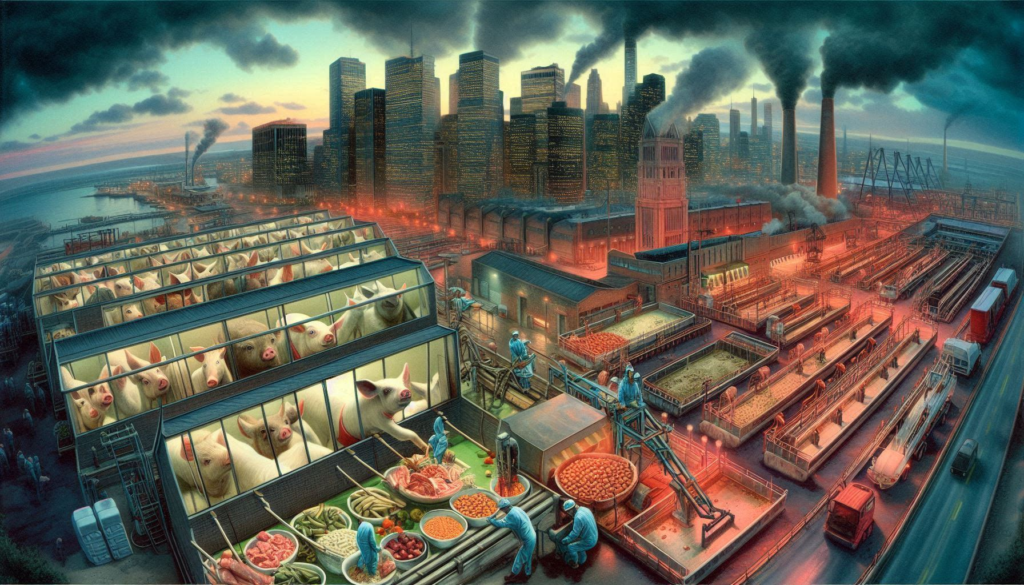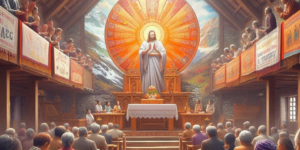
Abstract
Photographs can be a powerful instrument for synthesizing strong emotions within a frame, which aids the viewer to get hold of a wider realm. It can portray a message by itself or sometimes showcases a sheer warning to the conscience. Existing grammar regarding what is worth enough to be photographed or to be observed have changed drastically in the post- modern age. Bitter realities of personal and social life as well as non- human life have become the theories of new visual reality. Two photos regarding animal lives are used in this study to bring out the darker side of consumerism, which contradicts what they propose through their advertisements.
Keywords – Commodification, Visuality, Animals, Sensorial History
On Two Sides of Visuality
The visual bias based on the narrative reflected by a photograph can endorse each person differently, which is usually termed as the visuality. The spectrum (Barthes,1980) here in both the images are animals, particularly farm animals. Photograph of the piglet (Image 1) encompasses a death in itself that has several dimensions to cater upon. Image of a dead farm animal wrapped in a thin plastic sheet usually symbolizes its identification as a commodity, ready to reach out the market. A closer check can reveal the weight, price tag, barcodes and other necessary details regarding the ‘product’, which is a piglet in its complete form. It is kept on a stack with other packed food products; a common sight in western markets. This is invariably a part of the cultural and social life, and a day to day sight in malls and markets everywhere. Thus the studium (Barthes,1980) of the photograph can be summarized.

On the other hand, the punctum, which in turn has a wider emotional connotation that pricks the conscience of the Spectator has a role in this image as well. Some spectators can sense a tinge of pain involved in the photo, as the theme is ofcourse a death, or one should dig a bit deep- it is a murder! The creature here- piglet, as shown is too young to be slaughtered can hurt morale as well. In an artistic sense, the piglet is still holding a tender smile even in its phase of death. The smile here has a deeper meaning beyond the aesthetic beauty as a commodity. It engulfs a question to the whole of humanity, where the smile represents forgiveness while embracing death silently. Thus the face of the month old piglet represents billions of farm animals which suffered silently in the darker rooms of slaughter houses denying even a childhood for its own. Here, the visuality grows out of the mere tagline of a ‘commodity’ to a wider realm of questions of animal ethics and rights. Thus ‘photography is subversive nor when it frightens, repels, or even stigmatizes, but when it is pensive, when it thinks’ (Barthes,1980), becomes valid here.

Photographic ‘Shocks’
A ‘good’ photograph which fulfills all its aesthetic duties is generally appreciated and widely accepted. Once they feel the aesthetic quality being disrupted due to any critical components, the photograph might then be subjected to several contestations. Animal ethics being one among such widely debated topics in general, is intentionally avoided for the sake of both consumers as well as producers usually. All interpretations can go invalid until the victim itself can speak out its feelings. This possesses a huge gap in analyzing animal ethics, as the victim is voiceless here and thus the whole narrative can go subjective. The materiality of the image; beyond the direct subject matter, is releasing a shock, inflicting pain and empathy in the spectator. Recognition of the binary- the oppressed and the oppressor, instills a sort of ethical responsibility while one goes through the first image. Hereby, the vision of the piglet is creating a newer narrative away from the normative theories of consumerism or establishing new perceptional encounters. Seeing the image makes us think beyond the languages of existing notions of humanity and thus creating a new emotional history.
All images being visual objects, the rupture created in mind is still not uniform for everyone. The intensity of sentiments of the viewer are subjected to his social, cultural and political background. His pre-existing cognitive structure, which conditions the mind decides how to react to a particular triggering event. The socio- religious customs and habits inflicting lesser status to animals has a history tracing long back. It is evident from the sources that treatment towards animals was more or less similar to the institution of slavery existed a century back. The human centric view upon the ecological pyramid is just another replication of what once slavery did towards helpless victims. Therefore a normalized human centric eye cannot identify the unsaid miseries of a ‘lesser valued’ life. This theory works behind reading the visuality of the given photographs in this context. The process of seeing the pity of animals is thus conditioned by a lot of external factors.
The ‘Mask’ of Capitalism
The second image is of a poster advertising good quality meat. The title as ‘Happy Cows- Mean Tasty Beef ‘ together with the artificial image of a ‘happy’ cow could be a perfect example of how advertising masks the entire reality. It effectively covered the political reality and showcased only the aesthetic side, which is an artificially drawn image of a happy cow. The reality that no animal would be happy to be killed is always known, still the process of ‘masking’ (Barthes,1980)- the capitalist tendency to promote their market, is widely promoted like that of any other commodity.
The symbol of barcode being attached to the ‘product’ in the image is the ultimate symbol of consumerism. Barcode on something represents its value being reduced merely to that of a product ready to get sold as per the market demand and supply. Here, the commodity is an animal, which has its own distinct life, but it is being ‘owned’ by humans. Our diet and needs decides their lifespan, reproduction and finally the nature of death. Capitalism just gives the people what they want (Mcmullen, 2015). The guiding ethics of capitalisation is maximization of profit. The frozen face of a piglet reflects the frozen human ethics towards the other beings having equal rights to live their lives. The images thus point towards the question of commodification of animals in capitalist milieu. Reification of animals is what utilitarianism has led us to (Lukács, 1923). Animals being the super-exploited commodities, considered as private property in the capitalist mode of production (Stache, 2019).

Reality in Modernity
Modernity is commonly regarded as increased secularization of society through which there is an upsurge in the role of marginalized sections in the civil society (Taylor,1995). The post modern period even went deeper to include non-human beings in the category of ‘marginalized’ due to the unimaginable oppression humanity has been doing towards them from time immemorial. Growth of reason and rationality started to question the prevailing theories of man as the center of creation. Rationality is at best, a questionable criterion for moral considerability (Clark, 1984). There is an upsurge of deculturation of older patterns of traditions which is also evident from the photographs of the modern period. Unethical treatment for animals being one among those ideas which is already proven unsustainable and no independent rational grounding behind.
A strong ‘ethics of seeing’ thus being impacted by newer values of inclusion, recognition and consideration towards animals began to gain popularity. The images also point towards the recent animal liberation movements and emerging vegan lifestyle where activists publicize such real images to campaign for animal rights and to bring out the horror behind the walls of farm houses. Thus these pictures are themselves a protest against the prevailing consumptionism and thereby bringing out a different political language for the voiceless.
Other than ethics and morality, which is highly subjective, the concept of justice is also being questioned in both the images. Depriving quality life for any sentient being is an unquestionable injustice. The piglet wrapped in a foil pinpoints towards the justice it was denied. And also, the poster instills its gravity by spreading false information and thereby allowing the general mass to compromise reality.
‘Aesthetic’ Death
A photograph is said to be a death in itself ; the moment it is captured it becomes a part of memory (Barthes,1980). Here, the photograph itself is a dead piglet. When death is captured, it becomes a more piercing sight for the audience. The death in this image is not natural. It is being inflicted upon the victim for the satisfaction of somebody’s cravings. Face of the piglet reminds us of the pain it might have undergone. The way death is captured in the photograph as well as the advertisement is also unnatural. A ‘veil of aesthetics’ can be seen in both inorder to cover the grounded reality. Neatly packed piglet along with other food products, ready for consumption normalizes the atrocities behind the scene. This normalization of animals being a commodity is superimposed everywhere through aestheticization of death.
Similar trend is visible in the advertisement poster as well. The ‘animal friendly’ glue traps (Dillard, 2004), spreading false information should be subjected to legal restraints. Faking animal condition is thereby a crime and it also blindfolds consumer ethics. The message consumers get here is not only fake, but completely opposite to what is happening in the real scenario. Misleading details and product description in this advertisement poster is more serious than other commodities because here it masks death which amounts to the greatest injustice. Like the thin foil which wraps the piglet, there is a foil of invisibility which separates the consumer from the actualities of the animal industry. This invisibility is purposefully created by the industrialists in order to prevent enthusiastic moralists from peeping into the ‘happy’ stories of blood and bones. Until this ‘wilful ignorance’ prevails, billions of lives will continue to be sacrificed.

CONCLUSION
This paper explores the contradiction between the surface appearance of images and the underlying realities they obscure, particularly in the context of animal ethics. It argues that modern capitalism commodifies animal lives, using visual tactics to normalize unethical practices and promote false information. By analyzing two images, the paper highlights how consumerism hides the grim realities of exploitation and death. The rise of visual evidence, especially in the form of images and videos, has brought speciesism and animal rights into sharper focus. This has led to a new political language for animal rights and a growing discourse on sustainable consumerism.
References
- Barthes, Roland. (1980). Camera Lucida :Reflections On Photography. Hill and Wang.
- Clark, Stephen R.L. (1984), The Moral Status Of Animals. Oxford University Press.
- Dillard, Carter.(2004).False Advertising, Animals, and Ethical Consumption. Animal Law Review, Vol. 10,25.
- Lukacs,Georg.(1923). Reification and the Consciousness of the Proletariat .Merlin Press.
- Mcmullen, Steven.(2015). Is Capitalism to Blame? Animal Lives in the Marketplace. Journal On Animal Ethics, Vol. 5, 126-134.
- Sontag, Susan.(1977). On Photography. Farrar,Straus & Giroux.
- Stache, Christian.(2019).Conceptualising animal exploitation in capitalism: Getting terminology straight. Capital & Class, Vol. 44(3), 401–421.
- Taylor, Charles.(1995).Two Theories of Modernity.The Hastings Center Report,Vol. 25, No. 2 (Mar. – Apr., 1995), 24-33.




